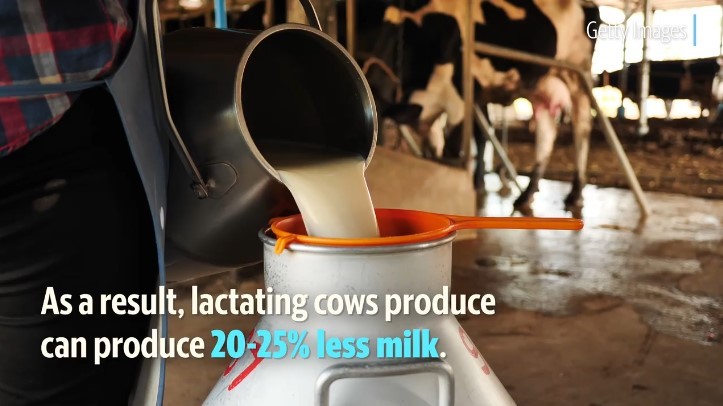
The cost of dairy products may go up as milk production drops due to heat
waves and drought in the Northwest. BY JOSHUA BESSEX
The extreme heat forecast to return at the end of the week is an unwelcome guest to dairy farmers who are working around the clock to keep their cows and calves cool, and to the growers whose crops feed the animals.
“It is a two-edged sword. Feed is going up and (milk) production is going down. It will have a significant economic impact,” said Patti Brumbach, the executive director of the Washington State Beef Commission.
Multiple agencies and groups across the state told the Herald that it’s too early to know the full economic hit that dairy farmers may suffer.
However, the perfect storm of the higher cost of crops like alfalfa combined with less milk production could drive up prices for consumers.
By July 4, the U.S. Department of Agriculture reported that at least two-thirds of the rangeland and pastures in the state were rated in “very poor” to “poor” condition.
The USDA also predicts that crops that contribute to cattle feed also will take a hit — with production of barley being reduced 51 percent this year.
CATTLE DEATHS
The Herald confirmed reports with the Department of Ecology that there were 1,000 or more cattle deaths throughout Washington state during the late June heat wave.
But Kimmi Devaney, a spokesperson for the Dairy Farmers of Washington, said few of those deaths were dairy cows.
Still, the state’s head veterinarian, Dr. Brian Joseph said be believes the dairy industry’s financial loss could be extensive.
“Lactation may go down 20 percent to 25 percent,” he said “Dairy farmers are not rolling in money, and makes it worse for them.”
The Washington State Department of Agriculture veterinarian told the Herald that during times of extended high heat, cows expend a bulk of their energy to keep themselves cool, and they lose their appetite. As a result, lactating cows produce less milk.
Joseph said there are a lot of things that farmers do to protect the cows and calves, including installing misters in barns and on their property, keeping cool water in troughs and using fans to circulate cool air.
But when temperatures are 100+ degrees for long stretches, there is a limit to a farmer’s resources.
When temperatures hit 90, the risk to dairy cows is considered severe — labeled an emergency situation when most animals are severely heat stressed and struggling, according to data from the Washington State University Extension office’s “Livestock Heat Stress: Recognition, Response,and Prevention.”
That is when farmers take those extra precautions to keep the animals cool to prevent deaths.
However, Joseph said, “The American consumer is not really sympathetic. They don’t think much about dairy farmers and ranchers.”
He said that with colder winters and hotter summers, there could continue to be tragedies like two years ago when a blizzard killed 1,800 head of cattle in Eastern Washington at an economic loss of $4 million.
STUNTED CROPS
Hay growers and feed producers also are getting slammed.
“This is an emergent situation that will cause big problems,” Joseph said. “Food supply is really really important.”
Dan Wood, the executive director of the Washington Dairy Federation said that even before the heat dome hit in late June, growers were concerned about their crops.
He said that one farm’s first hay cutting in early June produced 25 percent and the farmer didn’t know if he would get a second cutting this year.
Typically, forage crops like alfalfa can be harvested three to five times a season depending on the type. Alfalfa can be cut up to five times depending on the growing environment.
Wood said later in the year feed will likely will be in scarce supply and prices will be higher.
“It is going to be day by day,” he said.
For now, Wood said, “The focus of dairy farmers is not on the revenue. They are making sure there is shade and fans and mist spraying for animals.”
Calculating the loss will come later.

























